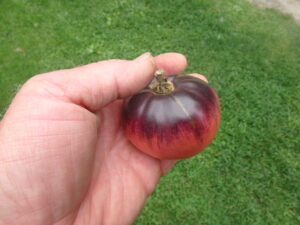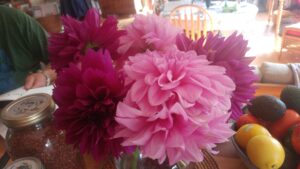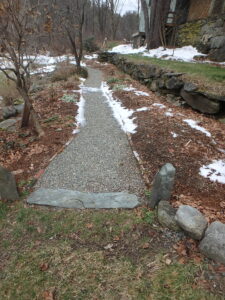The Year in Review: 2020
Posted on Tuesday, December 29, 2020 · Leave a Comment
This past year was a tough one for many of us: isolation due to Covid-19, political turmoil, employment interruptions and more. But in the garden? For me, it was pretty good, overall. It was a very dry summer, but that meant that there were fewer fungal diseases on my tomatoes and phlox. Since a small stream passes through my property the water table is high, and my established plantings did fine with little supplemental watering.
Let’s start in the vegetable garden. What tomatoes did best for me? For sheer production, it was one called “Big Mama”. She is shaped like a plum tomato, but 3 times the size or more. Flavor-wise it was not spectacular for fresh eating, but it was great for making sauce. I got seeds from Burpee.

Blue Beauty Tomato
My best flavored tomato? One I bought as a seedling called Hungarian Heart. It is a big, juicy tomato that makes any sandwich memorable. I ate them for breakfast, lunch and dinner when I had them. Seed for this heirloom tomato are available from The Seed Savers Exchange or Burpee seeds. And since it is an heirloom, you can save seeds from this year’s harvest to use next year.
Equally tasty is a perennial favorite of mine, the Sun Gold cherry tomato. Early, relatively disease-free, highly productive. It’s a modern hybrid, so you’ll need to buy seeds or plants every year. But buy them early: they sell out fast. Great for snacking or in salads, I also dehydrate them by the hundred and use in soups, stews and salads all winter.
Best looking early tomato? One called Blue Beauty. It starts out blue, but ripens to be a red tomato with black shoulders. Very productive with 6-to 8-ounce tomatoes and a nice flavor. Hybrid. Seeds available from Pine Tree Garden Seeds.

Dahlias make nice cut flowers
Best annual flowers? My wife Cindy ordered 18 Dahlia tubers last winter, and we started them indoors last March in 12-inch pots. We grew them under lights until mid-June when the soil was warm enough to please this heat-loving flower. They grew purple, pink and white 6-inch blossoms on 6-foot tall plants. We had more dahlia plants than any normal people would want, and even after we gave away a few, we had a forest of them.
These big plants had to be staked, and the only thing strong enough to support them were 1-inch square hardwood grade stakes, 5- or 6- footers. We dedicated one 8-foot by 3-foot flower bed to them, and scattered a few plants elsewhere.
For years I have been trying to find the perfect spot for a nice flowering shrub called Carolina allspice or sweetshrub (Calycanthus floridus). I moved it this year for the third time, and finally found a good spot. About ten years ago I planted it in full sun with moist soil, and the leaves burned. Then I put it in shade, and it didn’t flower much. This year I moved it to a drier location in dappled shade under a pear tree. It grew well, and appears to have settled in well.
Sweetshrub produces nice burgundy flowers in late June. Some varieties are very fragrant. Mine is not. (Note to self: always buy flowering plants when in flower if they are supposed to be fragrant).
We had a fierce windstorm in 2020, and it partially tipped over a 15-foot catalpa tree that we’d had for 3 years. I was able to push it back up to vertical position, but worried that it was unstable. I tied it to 3 stakes for a while. Then I had the idea to place a large stone over the rootball on the side that had lifted up. That really stabilized it, and I removed the ropes which had begun to dig into the bark. So far, so good, despite strong winds this fall.
For years I have been frustrated by weeds that infested a walkway though a terraced area for flowers. Goutweed and creeping grasses were seemingly impossible to eradicate, especially since the roots could hide under the large flat stones I had used as stepping stones. This year my wife, Cindy, decided to make it better.

Pea stone pathway lined with bricks was a big project but worth it
First, we removed all stepping stones and she dug out the weed roots. She hired three teenagers to wheelbarrow away the soil and help with the digging as she excavated the path. They dug out a pathway about eight inches deep, two-to three-feet wide and 80 feet long. They then put down 6 inches of one-inch crushed stone and covered it with landscape fabric. Then they edged it with bricks standing on edge, and filled it with rounded pea stones about half an inch across.
The project was a huge success: for the first time ever, we had no weeds in the walkway. Not one, all summer. Stone, with no soil mixed in, will not grow weeds and the bricks kept soil in the beds from getting into the pathway. We will be on the lookout for scraps of goutweed that might pop up at the edges of the walkway next year, but the landscape fabric will keep any scraps of root from sending up shoots.
Each year is different. Each year certain flowers or vegetables are supremely happy, and others sulk. That’s part of the fun of gardening: remembering the good, learning from the bad, and looking forward to the next year. My best wishes to you all for 2021.